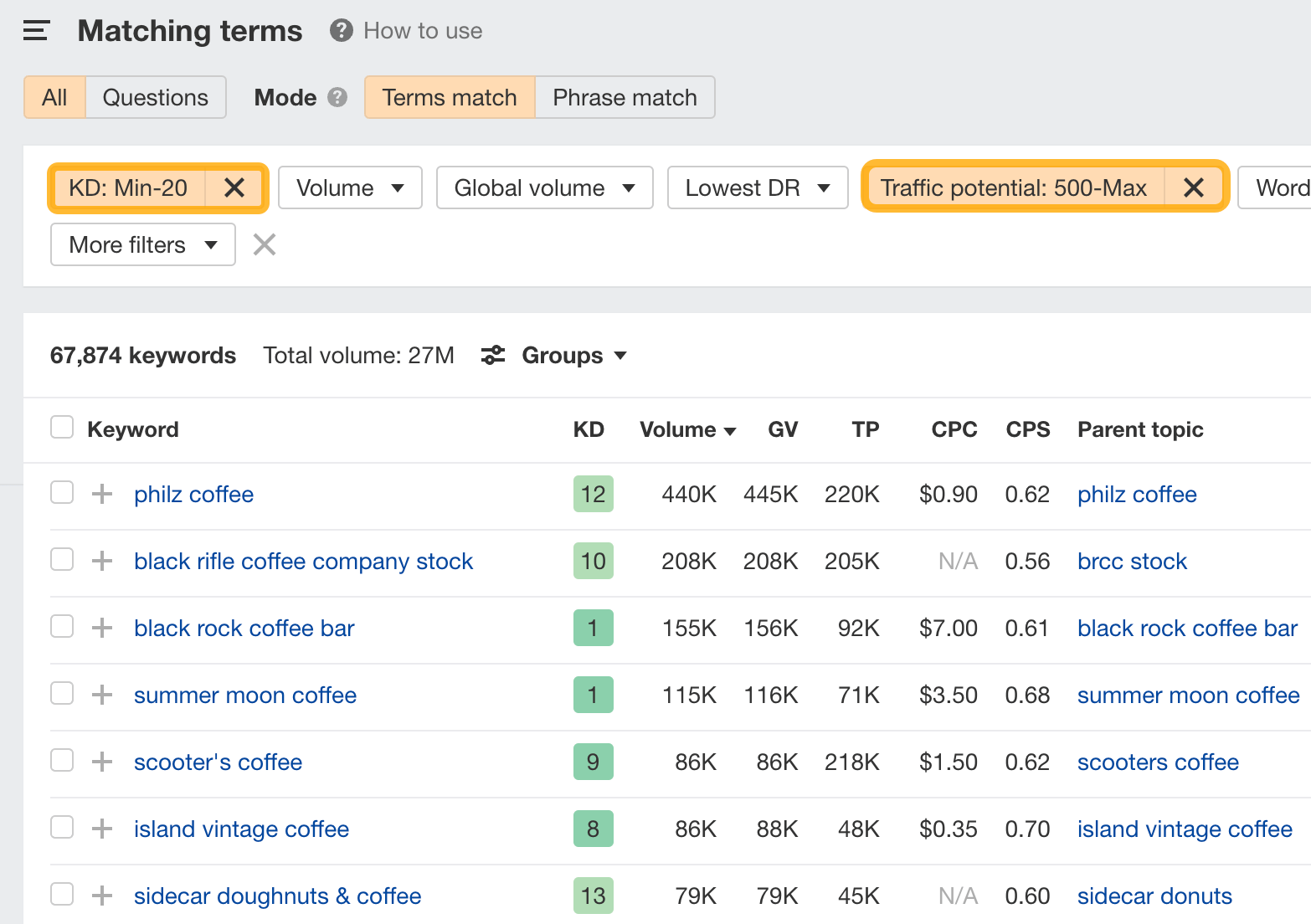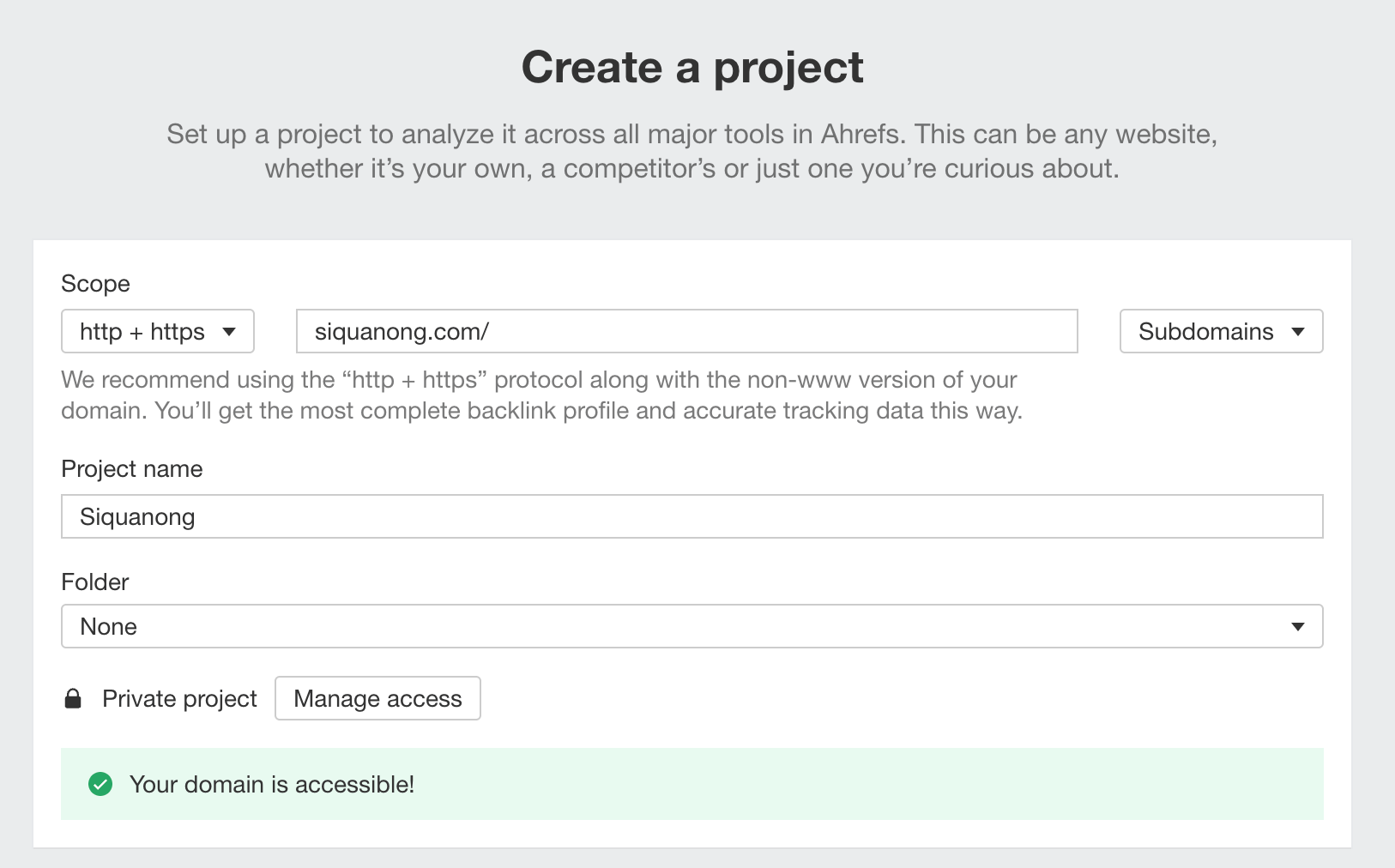Specifically, you need website content that:
- Ranks on Google – You need a way for people to discover your content. Google’s your best bet: 53.3% of all website traffic comes from organic search.
- Engages your audience – Your target reader should consume your content and be compelled to take the next step, whether it’s subscribing to your email list or buying your product.
In this post, you’ll learn how to create content that achieves both goals.
You can’t get search traffic if no one’s searching for your keywords on Google. That’s why the first step is to figure out what your target audience is searching for.
This process is known as keyword research.
To get started, make yourself a cup of joe, sit down, and ask yourself: “What would my target audience type in Google if they were looking for my website?”
For example, if your website sells coffee equipment, then someone may be searching for websites similar to yours using these keywords:
- Coffee
- Espresso
- Cappuccino
- Coffee beans
- French press
We’ll then take these keywords and use them as seeds in a keyword research tool like Ahrefs’ Keywords Explorer. So here’s what we’ll do:
- Go to Keywords Explorer
- Enter the keywords you’ve come up with (in this example, we’ll use the five coffee keywords)
- Go to the Matching terms report

Here, you see more than 4 million potential keywords you can target. However, not only is that too many, but most of them are also too competitive. After all, Google search doesn’t exist in a vacuum—if there are many websites vying for pole position, it becomes harder to rank.
So we want to narrow down the results. We’ll do this using two filters:
- Keyword Difficulty (KD) – How hard it is to rank for a particular keyword. We’ll set it to something low and manageable, around 20.
- Traffic Potential – The potential amount of search traffic your page can get if it ranks #1. We’ll set it to 500.

It’s much more manageable now. Go through the list and pick out the keywords you think are relevant to your site.
With a list of keywords to target, it’s time to create content.
Here’s how:
Choose your content format
Your content can be a listicle, a how-to guide, an opinion piece, or more.
Which one should you choose?
The most straightforward way is to look at what’s ranking in Google for your chosen topic. For example, if we look at the search engine results page (SERPs) for “how to save money,” we can see that—despite the two words “how to”—people are actually looking for a list of tips.

So if you’re tackling this topic, your content format will likely be a listicle. This helps you compete with the existing results on the SERPs.
Choose your angle
You’ll want to make your content specific so your audience can clearly identify its value. This is conveyed via your content’s angle.
For example, a blog post teaching how to cook fried rice fast has a clearer proposition than simply how to cook fried rice.
There’s no “best” or “correct” angle to select, so choose one that’s novel and interesting to your readers. Here are some questions that could spark ideas:
- Do you have personal experience or expertise? If you have a unique fried rice recipe, share it.
- Can you interview experts? For example, you can interview the chef making the fried rice that’s rated 4.5* on Google.
- Can you crowdsource ideas? For example, you can poll people part of r/chinesecooking on their best fried rice recipes.
- Can you back your content with data or science? For example, you can explain how to make egg fried rice using molecular gastronomy (and explain the science behind it).
Figure out important subtopics to cover
You don’t want to miss out on subtopics in your post—especially if it’s something searchers expect to see.
We can figure out what these subtopics are by looking at the common keyword rankings among the top-ranking pages:
- Enter your keyword (e.g., “inbound marketing”) into Ahrefs’ Keywords Explorer
- Scroll down to the SERP overview
- Select three to five top-ranking articles (make sure they’re similar)
- Click Open in and choose Content gap

Here, we’ll want to make sure to see only the most relevant subtopics. We’ll do this by selecting the Intersection dropdown and choosing the highest two targets (in this example, 4 and 5).

From here, we can see that searchers also want to know:
- The definition of inbound marketing.
- Examples of inbound marketing.
- Inbound marketing strategies.
If we’re covering the same topic (“inbound marketing”) from a similar angle (“beginner’s guide”), then these subtopics would make good subheadings.
Design your content to be readable
Nothing is worse than having to read a chunk of text. You’ll want to make your content comfortable to read and easy on the eyes.
You can do this using the ASMR formula:
- Annotations – Add elements like sidenotes, blockquotes, and call-out boxes to break up the monotony of the post.
- Short sentences and paragraphs – Break long sentences with lots of transitional words like “and,” “because,” and “that” into shorter ones.
- Multimedia – Including videos, images, and GIFs helps illustrate your points without extra words.
- Read your copy out loud – This pinpoints areas where the content doesn’t flow smoothly.
Write like how you talk
You don’t have to puke out a word salad to impress your readers. The best online writing is friendly and casual. Treat it as if you’re talking to a friend.
If you’re afraid your writing is too business-like, paste your draft into Hemingway:

Reel your readers in with an eye-catching headline
The famed adman David Ogilvy once said:
On the average, five times as many people read the headline as read the body copy.
People are busy. You need to catch their attention with the headline. So no matter how hard you work on your content, if your headline doesn’t hook them, they won’t read it.
The best way to come up with a good headline is volume. In other words, brainstorm as many possible headlines for your article as possible. Viral site Upworthy used to create 25 headlines for each of its articles, and bestselling author James Clear brainstormed 400 before coming up with “Atomic Habits”:
Fortunately for you, there’s a faster way to reach this volume today. You can use ChatGPT:

Don’t use what’s generated verbatim, but use it to spark inspiration and help you create the perfect headline.
Add your on-page SEO
On-page SEO focuses on helping Google and searchers understand and digest your content.
Follow these best practices:
- Use the keyword in the title (if possible)
- Write a compelling meta description that sells your article on the SERPs
- Add concise and accurate alt text to your images
Our content is well known in the SEO industry, and we’re often complimented for our content quality:
Our secret sauce? Peer review.
Each writer on our team is paired with another to review each other’s work. We point out inaccuracies, logical loopholes, structural issues, spelling errors, and grammatical mistakes. We help each other improve phrasing, suggest examples, or give more ideas.
This is so important to us that we even dedicate a section in the author’s box to contributors:

A writer can’t write alone—they’re too close to their own work. They need a third party with a fresh set of eyes to go through and provide feedback. That’s why authors hire editors—they’re there to sharpen the prose and tighten the copy.
If you have an editor to show your draft to, great. If not, you can always get the help of a friend, family member, or colleague.
Even if they don’t finish reading, it’s still helpful because it tells you where they stopped reading. That’s most likely the part where they lost interest, so you know where you need to improve.
Before you publish, run your draft through a tool like Grammarly to fix up any final grammatical, spelling, or phrasing errors.
Once that’s all done, hit ‘“publish.”
Then, head over to Ahrefs’ Rank Tracker and set up a project for your website.

Follow through the steps. And then in step #4, add the keyword(s) you’re targeting:

The tool will track your website’s ranking positions for the keywords you’ve added.
SEO is a continual process, and a tool like Rank Tracker will enable you to keep track of your underperforming content so you can improve it over time.
No. You can outsource.
To help you decide if you should create content yourself, here are a few points to consider:
- Do you like writing? If you feel like vomiting every time you sit down to write a post, you should consider outsourcing.
- Is content creation the most important thing you can do? I’m a content marketer, so writing is my most important task. But if you’re in another role, say an entrepreneur or a salesperson, then perhaps writing is not your “one thing.” It doesn’t mean you shouldn’t create content, but it may mean you don’t do the actual writing. (Remember: Many books are written by ghostwriters.)
- Are you overwhelmed with tasks? If you can never find time to create content, e.g., you’re a solopreneur, then it’s probably better if you outsource.
- Are you in an industry that requires domain expertise? For some industries (e.g., health), expertise is vital not just for the sake of your readers but for ranking. If you don’t have the required expertise, you may want to consider outsourcing it to someone who does. (Although you can overcome this through interviewing experts.)
- Do you have a budget for hiring? Time is money too, so it doesn’t mean you should create all the content yourself just because you don’t have a budget. Make sure it’s the most important thing you can do.
If you’ve decided to outsource, then you can start looking for freelance writers on job boards and marketplaces. There are general ones like Upwork, and there should also be ones specific to your industry (e.g., Swipe Files is a job board for marketers).
Final thoughts
If you follow through the steps above, you’ll create content that Google loves.
Over time, your efforts will be rewarded and you’ll see organic traffic flow to your website.
Any questions or comments? Let me know on Twitter.



